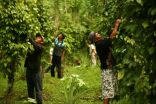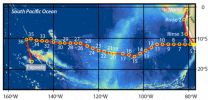(Press-News.org) In a recent article in Nature, Keith Shepherd and the Land Health Decisions team at the World Agroforestry Centre (ICRAF), together with their external partners, propose a radically new method to the SDG community that would answer these questions. They call on the United Nations and private sector to dispense with the highly criticized target setting approach and adopt the new method of decision analysis.
The target setting approach is widely seen as ineffective or counter-productive. Targeting emphasizes meeting a 'target' rather than learning how to improve performance and solve a problem. For example, 50% of women may be members of parliament but only a handful speak at meetings.
Target setting can incentivize mis-reporting information in order to meet the target. For example, incidents of crime may go unreported if the goal is to reduce crime incidents. And last but not least, it's an incredibly expensive endeavor to monitor and collect data.
An alternative to target setting
In an effort to avoid spending precious funds on another round of target setting and monitoring for the SDGs, Shepherd and team propose a new solution: decision analysis concepts and tools.
"In a way it's like putting up a whole new learning system rather then setting up a group of targets," says Shepherd. "Using decision analysis is about supporting people to make better decisions and better choices. We need to work on gathering the right information needed to improve decision making on the ground. We have the tools to do that now."
Decision analysis is not a new concept for everyone. It turns out that we humans aren't as good as we thought at choosing indicators that can actually improve decisions. A number of sectors have already caught on and have been using decision analysis for decades, including mining, oil, insurance, and cybersecurity, according to Shepherd.
Read the Nature article: Development goals should enable decision making
"An analysis of more than 80 models from a variety of decisions and industries reveals that managers tend to choose to measure variables that are unlikely to improve decisions while ignoring more useful ones."
So how do we identify the more useful indicators? The premise rests on pinpointing critical uncertainties in the real decisions facing stakeholders and working to reduce these uncertainties.
In the Nature article, Shepherd and colleagues propose five key principles towards implementing a decision analysis approach:
Replace targets with measures of return on investment
With limited development dollars, decision makers should understand how to maximize the impact of investments. We should be asking and answering questions such as, "were the environmental benefits and reduction of poverty enough to justify the allocation of limited funds?"
Decision makers should be using economic models that project long-term costs, benefits and risks of intervention options and help choose the best combination of interventions for achieving the desired set of development goals.
Model intervention decisions
According to an ICRAF study conducted in 2013, only 15% of stakeholders in African agriculture surveyed "were able to articulate how acquiring data would reduce a critical uncertainty to enable a decision."
Gathering data for the sake of data will be of little use in achieving the SDGs. Instead of creating indicators first, the SDG community should define which policies, programs or actions it is considering and then use decision analysis to identify what additional data will be useful to improve choices and track outcomes, quite similar to quantifying a theory of change in terms of expected impacts.
Integrate expert knowledge
Expert knowledge can help fill gaps where data is sparse. Experts often have a sound understanding of the realistic ranges that certain variables, such as the risk of drought or the future price of carbon, can take on. They also have a good feeling for how interventions work on the ground.
Research in support of development should make use of this vast source of knowledge, rather than restricting itself to new data that rarely allow much insight into cause-and-effect scenarios or provide much support for intervention decisions.
Include uncertainty in modeling activities
Anyone who follows climate conversations will be familiar with the concept of modeling future climate scenarios based on a number of factors including carbon emissions. Models are used to predict many other changes including crop growth, disease spread, and others. However, what they aren't very good at is including social and behavioral factors, and representing the levels of uncertainty of current knowledge, which decision analysis tools such as Monte Carlo simulations or Bayesian network models, can offer.
Measure the most informative factors
Decision analysis uses "value-of-information" analyses that determine how much decision-makers should be willing to pay for additional knowledge on a certain variable before making a decision. Areas that have high information value should be measured.
Will the funders take the leap?
"The whole process is a learning system", explains Shepherd, "we project impacts based on current understanding, measure where it will help improve our choices, monitor where things are most likely to go wrong, and continually update our projections and choices based on what we actually observe."
Shepherd and team have a very specific request: the UN, donors and private sector should fund a decision analysis task force. The task force will help clarify key decisions about development interventions, create methods for analyzing choices and tradeoffs, and design a capacity development program in decision analysis.
"I think this will need steering, piloting and proof of application because it is an entirely different approach to what many know in development. It will take quite a bit of work to enact change, however we have seen this transition happen in other fields" says Shepherd.
Is the development community ready to take a leap? To explore new ways of learning and embrace strategic guidance that could lead us closer to achieving the next set of development goals?
INFORMATION:
The quality of waters can be assessed using of the organisms occurring therein. This approach often results in errors, because many species look alike. Therefore, new methods focus on DNA analyses instead. Biologists at the Ruhr-Universität Bochum (RUB) have optimised the process so that they are now able to identify many organisms at once in a quick and reliable manner using short DNA sequences. The results have been published in the PLOS ONE magazine.
Expert knowledge for species identification threatens to disappear
Industry, agriculture and human settlement ...
Researchers at the University of Liverpool's Institute of Infection and Global Health (IGH) have discovered a common cause of heart damage in patients with sepsis.
Sepsis is the most common cause of death in hospitalised critically ill people and affects up to 18 million people world-wide annually.
The electrical and mechanical malfunctions of the heart have been poorly understood in sepsis, with underdeveloped clinical management strategies, as a consequence. This new discovery, however, promises to benefit a high number of patients with heart failure or rhythm ...
Since 1994, researchers at Case Western Reserve University have studied mothers--some who used cocaine while pregnant and others who did not--to understand how the drug affected their children's cognitive and social development.
Their latest findings suggest a link between prenatal cocaine exposure and an adolescent's likelihood to have sexual intercourse before age 15.
Teens who were prenatally cocaine exposed (PCE) were 2.2 times more likely to engage in sexual intercourse before age 15 than those who weren't, yet how PCE affects early sexual behavior may differ ...
This news release is available in German.
Some pollinators not only provide fertilization services for flowering plants, they also lay their eggs on the plants' leaves after they have visited the flowers. Voracious caterpillars hatch from these eggs and their enormous appetite can easily kill the plants. So when plants advertise for pollinators they frequently also attract herbivores. Scientists from the Max Planck Institute for Chemical Ecology in Jena, Germany, demonstrated in field trials that the flowers of the coyote tobacco Nicotiana attenuata are able ...
AMES, Iowa - Developing any habit--good or bad--starts with a routine, and exercise is no exception. The trick is making exercise a habit that is hard to break. According to a new Iowa State University study, that may be easier to accomplish by focusing on cues that make going for a run or to the gym automatic.
Some interventions designed to help people start and continue exercising may focus on the execution habit, or an exact routine to follow at the gym, said Alison Phillips, an assistant professor of psychology at Iowa State. However, Phillips' research, published ...
MANHATTAN, Kansas -- A new study led by a Kansas State University geneticist has shown that genomic signatures of adaptation in crop plants can help predict how crop varieties respond to stress from their environments.
It is the first study to document that these genomic signatures of adaptation can help identify plants that will do well under certain stresses, such drought or toxic soils, said Geoff Morris, assistant professor of agronomy at Kansas State University and a researcher affiliated with the university's Feed the Future Innovation Lab for Collaborative Research ...
Since their first discovery a generation ago, it has been recognized that hydrothermal vents at the bottom of the deep dark oceans represented unique habitats for exotic forms of life previously unknown to science. But what has gone quite overlooked, until now, is the role that these "rare, exotic" systems might play in regulating the global-scale chemistry of the oceans and, hence, the health and productivity of our planet as a whole.
A new study by researchers from University of Washington (UW), Old Dominion University (ODU), Woods Hole Oceanographic Institution (WHOI), ...
Strategies to support healthier diets among seniors need to take into account differences between elderly men and women, according to UBC research.
The two groups had varying responses to a tactic thought to boost seniors' fruit and vegetable intake, according to a study published in Appetite.
The study explored which types of social support encouraged seniors to boost their daily intake of fruits and vegetables.
Social support, typically provided by friends and family, comes in different forms. It ranges from emotional support, which bolsters one's sense of self, ...
One of the most important things to understand in battery technology is the precise physical and chemical processes that occur at the electrode/electrolyte interface. However, microscopic understanding of these processes is quite limited due to a lack of suitable probing techniques. Now, researchers at the US Department of Energy's (DOE) Lawrence Berkeley National Laboratory (Berkeley Lab) and the University of California, Berkeley, have developed a new technique that enables sensitive and specific detection of molecules at the electrode/electrolyte interface.
This new ...
Ann Arbor, MI, July 8, 2015 - Nearly 800,000 people in the U.S. suffer a stroke each year. Stroke is responsible for one out of every 19 deaths in the U.S. and it is a leading cause of disability. A new study published in the American Journal of Preventive Medicine found that secondhand smoke (SHS) increases the risk of stroke by about 30 percent for nonsmokers.
Using data from the Reasons for Geographic and Racial Differences in Stroke (REGARDS) study, a national, population-based, longitudinal study investigating cardiovascular disease events and mortality endpoints ...





